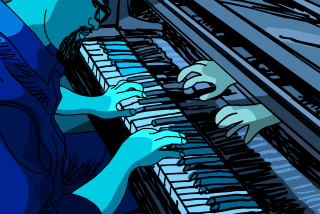JAZZ REVIEW : Ariel and Almario: A Passionate Merger of Talents
- Share via
SAN JUAN CAPISTRANO — Instrumental duos usually seem to fall short. Tempos drag while the musicians focus on melody and their harmonic blend. Or too much attention is paid to rhythm while lyrical form is forgotten. Often the pair is so involved in establishing a musical base that there’s no room for improvisational spark.
But when duos click, the music seems to take care of itself and the performance becomes a showcase of empathy and interplay. That was the case Saturday at the San Juan Capistrano Regional Library, where keyboardist Marcos Ariel and saxophonist-flutist Justo Almario teamed before an enthusiastic, standing-room-only crowd. The two showed an easy familiarity with their selected compositions, all but one penned by Ariel, and an almost clairvoyant sense of communication while playing in tandem.
Much is made over their South American connection--Almario grew up in Colombia, Ariel in Brazil--but their music, though borrowing frequently from less well-known Brazilian musical schools, made no easy connection with their native or any other ethnic traditions. Instead, the songs ranged across a variety of World-Beat influences, all laced together with a be-bopper’s intensity.
Ariel’s tunes, nearly all pulled from his latest album, “Rhapsody in Rio,” were dense, lyrical pieces that switched tempos as easily as a free agent switches ball teams. A strong propulsive sense marks his playing, the left hand charting beats and keys, the right providing counterpoint with melodic story lines.
A passionate user of dynamics, the keyboardist frequently took strong, full-blown chordal statements and reduced them to quiet, whispered reminders of his theme. His solo piece, “Morning Portea,” featured blues and ragtime figures that slid in and out of the churning tempo being set by his dancing left hand.
Almario added clear and crystalline soprano tones, regardless of how quickly played. His long, note-packed lines recalled Coltrane’s sheets-of-sound approach, but the saxophonist also added soft, sustained phrases so delicate they threatened to crack. His tenor, as heard on Ariel’s “Afternoon in Ipanema,” was both breathy and biting, displaying relaxed airs that swelled into strong, long-winded blowing.
Together, the two men encouraged and challenged each other, stating themes in a sharp unison, or matching ideas during up-tempo exchanges. Ariel’s accompaniment, neither too busy nor too spare, painted lush chordal backdrops that framed the saxophonist’s spirited solos.
Almario picked up the flute for his own “Quiet Wind,” a tune written to suggest the Andean breezes of his native land. The flutist’s shivering vibrato created a pastoral sound suggestive of wooden pan pipes before the solo grew into a resounding, majestic climax.
The only disappointing tune of the evening was Ariel’s “Calma,” a soupy ballad that was salvaged briefly by Ariel’s Erik Satie-like keyboard passage and a hard-hitting staccato exchange with Almario’s soprano. Like a high-powered sports car, these two seemed to perform best at high speeds.
More to Read
The biggest entertainment stories
Get our big stories about Hollywood, film, television, music, arts, culture and more right in your inbox as soon as they publish.
You may occasionally receive promotional content from the Los Angeles Times.










